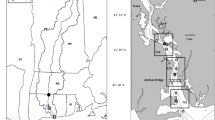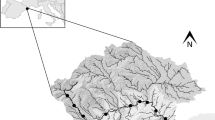Abstract
Lake Markermeer, a large shallow lake in The Netherlands, suffers from turbidity and ecology problems. As part of a study aiming to mitigate these problems, we study flocculation processes in the lake; in particular, the possible mutual flocculation between algae and re-suspended bed sediments. We show that sediment re-suspended from the bed of the lake can flocculate, forming flocs for which size is a function of the turbulence level in the water column. Moreover, we also demonstrate that algae and re-suspended bed sediments can mutually flocculate, yielding organic-inorganic aggregates. These aggregates have different features to those of their individual components, some of which have been measured and characterized in this paper. Furthermore, the characteristics of the resulting organic-inorganic flocs are strongly influenced by the type of algae in the aggregate. We found that, in the case of flocs consisting of bed sediments and filamentous algae, flocculation yields smaller flocs than for bed sediments only, resulting in an increased turbidity in the water column. In the case of flocs consisting of bed sediments and colonial algae, flocs grow faster and become larger than bed sediment flocs, which may result in the depletion of most colonies from the water column.



























Similar content being viewed by others
References
Bainbridge ZT, Wolanski E, Álvarez-Romero JG, Lewis SE, Brodie JE (2012) Fine sediment and nutrient dynamics related to particle size and floc formation in a Burdekin River flood plume, Australia. Mar Pollut Bull 65(4–9):236–248
Bale AJ, Morris AW (1987) In situ measurement of particle size in estuarine waters. Estuar Coast Shelf Sci 24(2):253–263
Berlamont J, Ockenden M, Toorman E, Winterwerp J (1993) The characterisation of cohesive sediment properties. Coast Eng 21(1):105–128
Bouyer D, Coufort C, Liné A, Do-Quang Z (2005) Experimental analysis of floc size distributions in a 1-L jar under different hydrodynamics and physicochemical conditions. J Colloid Interface Sci 292(2):413–428
de Lucas Pardo MA, Bakker M, van Kessel T, Cozzoli F, Winterwerp JC (2013) Erodibility of soft freshwater sediments in Markermeer: the role of bioturbation by meiobenthic fauna. Ocean Dyn 63(9–10):1137–1150
Droppo I, Walling D, Ongley E (2000) Influence of floc size, density and porosity on sediment and contaminant transport. IAHS Publ Int Assoc Hydrol Sci 263:141–147
Dyer K, Manning A (1999) Observation of the size, settling velocity and effective density of flocs, and their fractal dimensions. J Sea Res 41(1):87–95
Fettweis M, Francken F, Pison V, Van den Eynde D (2006) Suspended particulate matter dynamics and aggregate sizes in a high turbidity area. Mar Geol 235(1):63–74
Fugate DC, Friedrichs CT (2003) Controls on suspended aggregate size in partially mixed estuaries. Estuar Coast Shelf Sci 58(2):389–404
Guide O (1998) Malvern Mastersizer 2000. Malvern Instruments Ltd., Worchestershire
Hiemenz PC, Rajagopalan R (1997) Principles of colloid and surface chemistry, revised and expanded. New York, CRC Press
KIWA (1976) Bekerglasproef voor coagulatie. 1. Mengtijden en g-waarden
Lartiges BS et al (2001) Composition, structure and size distribution of suspended particulates from the Rhine River. Water Res 35(3):808–816
Lee BJ, Toorman E, Molz FJ, Wang J (2011) A two-class population balance equation yielding bimodal flocculation of marine or estuarine sediments. Water Res 45(5):2131–2145
Lunau M, Lemke A, Dellwig O, Simon M (2006) Physical and biogeochemical controls of microaggregate dynamics in a tidally affected coastal ecosystem. Limnol Oceanogr 51(2):847
Manning AJ, Baugh JV, Spearman JR, Whitehouse RJ (2010) Flocculation settling characteristics of mud: sand mixtures. Ocean Dyn 60(2):237–253
McCabe JC (1991) Observations of estuarine turbulence and floc size variations. Thesis, Polytechnic South West Institute of Marine Studies, Plymouth in collaboration with Plymouth Marine Laboratory, Plymouth
Mehta A et al (2009) Resuspension dynamics in Lake Apopka, Florida. Final synopsis report, submitted to St. Johns River Water Management District, Palatka, Florida, June 2009, Report No. UFL/COEL-2009/00, p 158
Mietta F (2010) Evolution of the floc size distribution of cohesive sediments. Delft University of Technology, TU Delft
Mietta F, Chassagne C, Manning AJ, Winterwerp JC (2009a) Influence of shear rate, organic matter content, pH and salinity on mud flocculation. Ocean Dyn 59(5):751–763
Mietta F, Chassagne C, Winterwerp J (2009b) Shear-induced flocculation of a suspension of kaolinite as function of pH and salt concentration. J Colloid Interface Sci 336(1):134–141
Mikkelsen OA (2002) Examples of spatial and temporal variations of some fine-grained suspended particle characteristics in two Danish coastal water bodies. Oceanol Acta 25(1):39–49
Mikkelsen O, Pejrup M (1998) Comparison of flocculated and dispersed suspended sediment in the Dollard estuary. Geol Soc Lond, Spec Publ 139(1):199–209
Mikkelsen OA, Pejrup M (2000) In situ particle size spectra and density of particle aggregates in a dredging plume. Mar Geol 170(3–4):443–459
Nagata S (1975) Mixing: principles and applications. Kodansha, Tokyo, Chap. 6
Noordhuis R, Houwing E (2003) Afname van de driehoeksmossel in het markermeer. RIZA report
Sanford LP, Suttles SE, Halka JP (2001) Reconsidering the physics of the Chesapeake Bay estuarine turbidity maximum. Estuaries 24(5):655–669
Sperazza M, Moore JN, Hendrix MS (2004) High-resolution particle size analysis of naturally occurring very fine-grained sediment through laser diffractometry: research methods papers. J Sediment Res 74(5):736–743
Van der Lee W (2000a) Parameters affecting mud floc size on a seasonal time scale: the impact of a phytoplankton bloom in the Dollard estuary, The Netherlands. Proc Mar Sci 3:403–421
van der Lee WTB (2000b) Temporal variation of floc size and settling velocity in the Dollard estuary. Cont Shelf Res 20:1495–1511
van Duin EHS (1992) Sediment transport, light and algal growth in the Markermeer. Ph.D. Thesis, Agricultural University, Wageningen
Van Eerden M, van Rijn S (2003) Redistribution of the Cormorant population in the IJsselmeer area. Cormorant Res Group Bull 5:33–37
Van Kessel T, Boer GD, Boderie P (2008) Calibration suspended sediment model Markermeer. Deltares, report Q, 4612
Van Leussen W (1994) Estuarine macroflocs – their role in finegrained sediment transport. PhD-thesis, Utrecht University, The Netherlands
Vdović N, Obhođaš J, Pikelj K (2010) Revisiting the particle-size distribution of soils: comparison of different methods and sample pre-treatments. Eur J Soil Sci 61(6):854–864
Verney R, Lafite R, Brun-Cottan J-C (2009) Flocculation potential of estuarine particles: the importance of environmental factors and of the spatial and seasonal variability of suspended particulate matter. Estuar Coasts 32(4):678–693
Verney R, Lafite R, Claude Brun-Cottan J, Le Hir P (2011) Behaviour of a floc population during a tidal cycle: laboratory experiments and numerical modelling. Cont Shelf Res 31(10):S64–S83
Verspagen JM, Visser PM, Huisman J (2006) Aggregation with clay causes sedimentation of the buoyant cyanobacteria Microcystis spp. Aquat Microb Ecol 44(2):165–174
Vijverberg T, Winterwerp J, Aarninkhof S, Drost H (2011) Fine sediment dynamics in a shallow lake and implication for design of hydraulic works. Ocean Dyn 61(2–3):187–202
Winterwerp JC (1998) A simple model for turbulence induced flocculation of cohesive sediment. J Hydraul Res 36(3):309–326
Winterwerp J (2002) On the flocculation and settling velocity of estuarine mud. Cont Shelf Res 22(9):1339–1360
Author information
Authors and Affiliations
Corresponding author
Additional information
Responsible Editor: Jeremy Spearman
This article is part of the Topical Collection on the 12th International Conference on Cohesive Sediment Transport in Gainesville, Florida, USA, 21-24 October 2013
Rights and permissions
About this article
Cite this article
de Lucas Pardo, M.A., Sarpe, D. & Winterwerp, J.C. Effect of algae on flocculation of suspended bed sediments in a large shallow lake. Consequences for ecology and sediment transport processes. Ocean Dynamics 65, 889–903 (2015). https://doi.org/10.1007/s10236-015-0841-y
Received:
Accepted:
Published:
Issue Date:
DOI: https://doi.org/10.1007/s10236-015-0841-y




